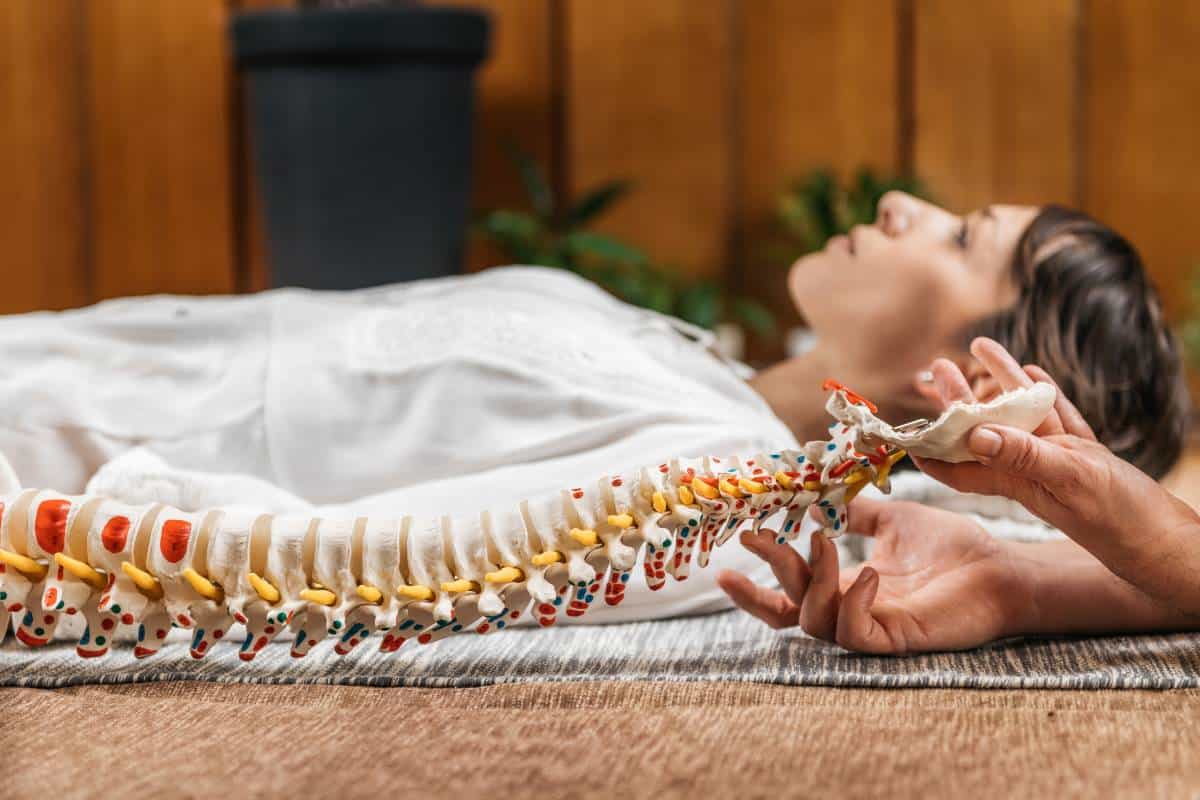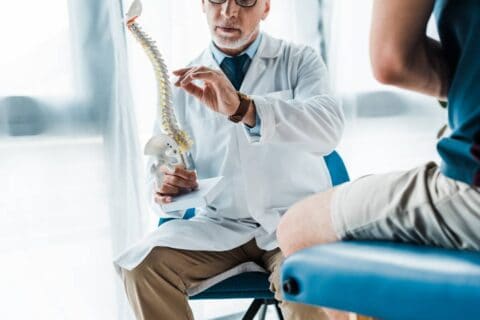As a chiropractor in Mt. Pleasant, I’ve seen firsthand the transformative power of combining spinal decompression techniques can be a vital part of your treatment plan for relieving pressure on the spinal discs. Chiropractic care can be an effective way to address issues like spinal restrictions and improve overall wellness. We combine many different modalities to produce long lasting results for our patients. Read and find out how!
Key Takeaways
- Combining spinal decompression therapy and chiropractic care offers a powerful, holistic approach to treating chronic back pain
- This integrated treatment addresses both structural and functional aspects of spinal health for optimal results
- Personalized treatment plans and ongoing patient education are crucial for long-term success, especially when considering non-invasive treatment options for conditions like spinal stenosis.
Synergizing Spinal Decompression and Chiropractic Care
Picture this: You’re at your desk, hunched over your computer when suddenly a sharp pain shoots through your lower back. Sound familiar? You’re not alone.
Back pain is the uninvited guest at many of life’s parties, from morning commutes to evening Netflix binges, often caused by issues like spinal stenosis. In fact, 80-90% of the general population will experience back pain at some point in their lives.
But what if I told you there’s a dynamic duo in the world of spine care that’s giving back pain the boot, but is it addressing the underlying spinal compression?
Enter the power couple of spinal decompression and chiropractic adjustments can help realign the vertebrae and alleviate symptoms related to spinal stenosis.1 These two treatments are like peanut butter and jelly for your spine – great on their own, but even better together.
Is SpineMed Your Path to a Pain-Free Life?
Tired of living with back pain? Take our quick quiz to see if you’re a candidate for the breakthrough SpineMed Treatment. It only takes a few minutes to potentially change your life.
Understanding Spinal Decompression
Let’s start with spinal decompression. Imagine your spine as a stack of coins with tiny cushions between each one. Over time, these cushions (we call them discs) can get squished, causing all sorts of trouble.
Spinal decompression is like a gentle stretch for your spine, creating space between those coins and allowing the cushions to bounce back.2
This technique works through various methods, including motorized traction, where a high-tech table gently stretches your spine, and inversion therapy, which involves hanging upside down (don’t worry, we’ve got special equipment for this!), but we feel our state of the art Spine Med machine is the first class way to go.
The Role of Chiropractic Care
Now, let’s talk about my bread and butter – chiropractic care. If spinal decompression is like stretching your spine, think of chiropractic adjustments as fine-tuning it. We’re not just cracking backs here; we’re conducting a symphony of spinal health.
Chiropractic care focuses on aligning your spine for optimal function, reducing nerve irritation, and improving overall mobility. It’s like hitting the reset button on your body’s operating system.
And the best part? It’s all-natural, drug-free, and tailored to your specific needs. By addressing these key aspects of spinal health, we’re not just treating symptoms but working towards long-term wellness and relieving pressure on the spine.
The Synergy of Combined Therapy
Now, here’s where the magic happens. When we combine spinal decompression with chiropractic care, it’s like assembling the Kobe and Shaq of back pain relief. This dynamic duo works together to enhance overall pain relief, improve spinal stability, and address both symptoms and root causes.
Studies have shown that combining these treatments leads to more comprehensive pain relief and better outcomes3. This synergy enhances both treatments’ benefits, offering a holistic approach to spinal health that addresses alignment issues while also promoting muscular rehabilitation.
The Treatment Process
So, how does this all play out in practice? Let me walk you through a typical treatment journey. We start with an initial assessment where we’ll chat about your symptoms, lifestyle, and goals, including any concerns about spinal compression.
Think of it as speed dating but for your spine. Based on this, we create a personalized treatment plan because every spine is unique, and your treatment should be too.
The combination therapy sessions usually involve utilizing spinal decompression and chiropractic adjustments over several weeks.
Throughout this process, we’ll keep tabs on your improvement and adjust as needed. It’s like having a personal trainer for your spine!
Rome wasn’t built in a day, and neither is a healthy spine. Patience and consistency are key here.
Technological Advancements in Spinal Decompression
Now, let’s geek out for a moment about the cool tech we’re using. Spinal decompression has come a long way from the days of hanging people upside down (though regular folks still do that sometimes, and it’s pretty fun).
Today, we’re working with computer-controlled decompression systems for precise treatment, real-time biofeedback to tailor the experience to your body’s responses, and advanced imaging techniques for accurate diagnosis and treatment planning.

Comparison with Other Back Pain Treatments
You might be wondering, “Doc, how does this stack up against other treatments?” Great question!
While medications offer quick relief, they’re often temporary and can have side effects.4 Physical therapy is an active needed approach for rehab but can be limited in results by not decompressing the spine. Surgery addresses severe issues but is invasive and requires a long recovery.
Our combined approach of decompression and chiropractic care offers a sweet spot of effectiveness without the drawbacks of more invasive treatments. It’s non-invasive and comprehensive, though it does require commitment from the patient.
Scientific Evidence and Case Studies
Now, I know what you’re thinking – “Sounds great, Doc, but where’s the proof?” I’m glad you asked!
The science behind this combined approach is solid. Studies have shown significant improvements in pain relief and function for patients receiving both spinal decompression and chiropractic care.
For example, a study published5 found that patients with chronic low back pain experienced greater improvement when receiving both treatments compared to either treatment alone.
But don’t just take the research’s word for it. I’ve seen countless success stories in my own practice.

Holistic Lifestyle Approach for Spinal Health
Speaking of being the CEO, let’s talk about creating a spine-friendly lifestyle. It’s not just about what happens on the treatment table; it’s about how you live your life every day. Regular exercise keeps your body moving and strong.
Weight management reduces strain on your spine. Good sleep hygiene ensures your spine gets its beauty rest too. And mind-body practices like yoga and tai chi are like spa days for your spine, helping to relieve pressure and improve spinal health.
All these elements work together to create an environment where your spine can thrive.
Potential Risks and Considerations
Now, I wouldn’t be doing my job if I didn’t mention that, like any treatment, there are some considerations to keep in mind. Spinal decompression and chiropractic care are generally safe, but they’re not for everyone.
Certain conditions may contraindicate these treatments, and there can be mild soreness after sessions (like a post-workout feeling). It’s crucial to work with qualified practitioners (like yours truly!). Always chat with a healthcare provider, or you can book a consultation with me so we can discuss your concerns.
Is SpineMed Your Path to a Pain-Free Life?
Tired of living with back pain? Take our quick quiz to see if you’re a candidate for the breakthrough SpineMed Treatment. It only takes a few minutes to potentially change your life.
FAQs
How can a chiropractor help with my back pain?
How long does a typical combined treatment session last?
How soon can I expect to see results?
Can this combined approach help with herniated discs?
How do chiropractors use spinal decompression in treatment?
Conclusion
Try combining spinal decompression with chiropractic care! It’s a powerful one-two punch against back pain, offering a comprehensive, non-invasive approach to spinal health. Remember, your spine is the backbone of your health which houses your nervous system. By embracing this integrated approach, you’re not just treating symptoms; you’re investing in a healthier, more mobile future.
Don’t let back pain write your life story. Take control of your spinal health today! Schedule a consultation with me, Dr. Mario Tolj, and let’s create a personalized plan to get you back to doing what you love, pain-free.
- https://www.ncbi.nlm.nih.gov/pmc/articles/PMC2780929/ ↩︎
- https://www.sciencedirect.com/topics/veterinary-science-and-veterinary-medicine/spinal-decompression ↩︎
- https://www.ncbi.nlm.nih.gov/pmc/articles/PMC1887522/ ↩︎
- https://www.ncbi.nlm.nih.gov/books/NBK560692/ ↩︎
- https://www.sciencedirect.com/science/article/abs/pii/S1529943011001288 ↩︎
Blog Disclaimer: The information provided on The BodyFix Chiro blog is for general informational and educational purposes only and is not intended as medical advice. These articles reflect our opinions and experiences but should not be used to diagnose or treat any health conditions. Always consult with your physician, chiropractor, or other qualified healthcare provider before starting any new treatment, exercise program, or making changes to your health routine. Any actions you take based on information from this blog are entirely at your own risk, and The BodyFix Chiro and its contributors disclaim any liability for the decisions you make based on this information.




